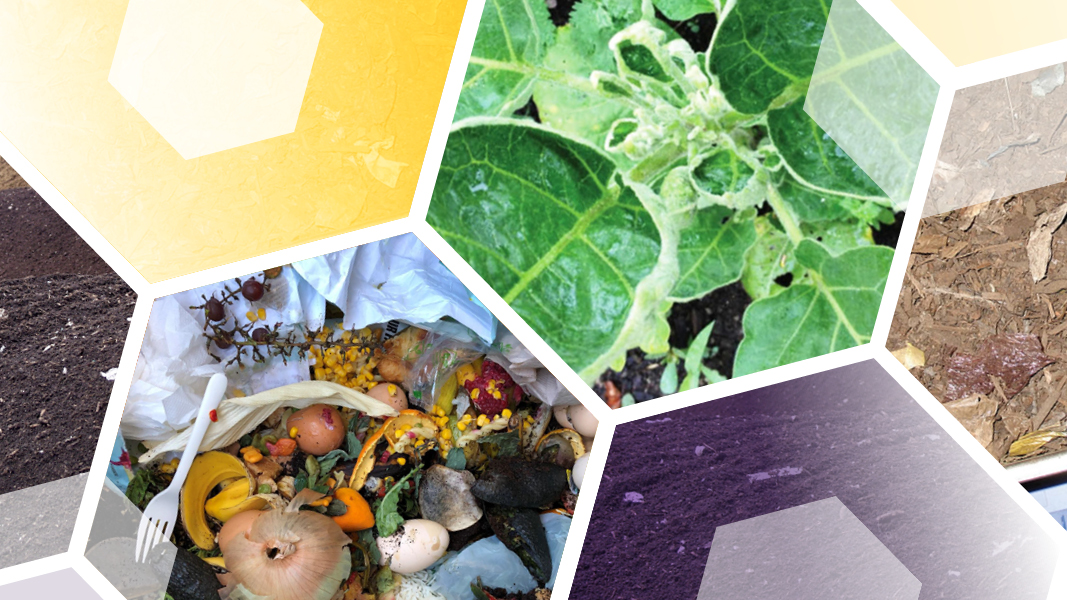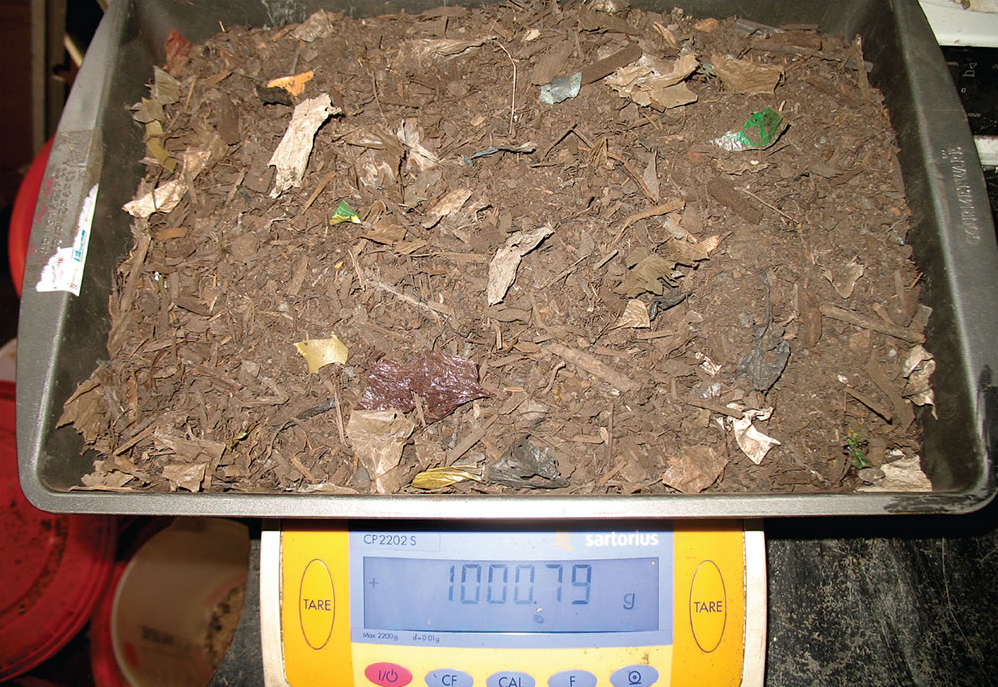Nora Goldstein
So much of the research and writing I’ve been doing lately relates in one way or another to addressing the presence of contamination associated with food waste streams destined for composting and/or anaerobic digestion. In the world of organics recycling, plastics contamination in feedstocks has always been a reality. More recently — as in the past five years or so — per- and polyfluoroalkyl substances (PFAS) contamination in feedstocks (food scraps, yard trimmings, biosolids) and in the finished products (compost, digestate) has reared its ugly head.
These “inconvenient truths” cast shadows over programs and policies that advocate recycling of food that ends up in the waste stream. In September 2015, the U.S. Environmental Protection Agency (EPA) and the U.S. Department of Agriculture announced the U.S. Food Loss and Waste Reduction Goal to halve food loss and waste by 2030. Integral to that goal is encouraging diversion of food waste from landfills — where it emits methane before landfill cells are capped — to composting and anaerobic digestion facilities. The challenges presented by contamination from plastics and persistent chemicals led the EPA’s Office of Research and Development (ORD) to commission “emerging issues” papers to help the agency “better understand the potential risks to human health and the environment” from these contamination sources.
Plastics Contamination
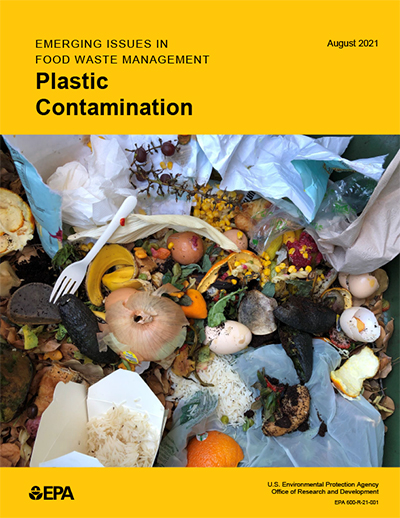 Emerging Issues In Food Waste Management: Plastic Contamination covers a wide range of topics: Sources of plastic contamination in food waste and the impacts on recycling these materials; contamination in the finished products and the impact on the value of those products; risks to environmental and human health; standards and regulations; preventing contamination; and role of compostable products. The paper concludes with research gaps. Information was culled from both peer-reviewed literature and “grey” literature (e.g., articles in BioCycle).
Emerging Issues In Food Waste Management: Plastic Contamination covers a wide range of topics: Sources of plastic contamination in food waste and the impacts on recycling these materials; contamination in the finished products and the impact on the value of those products; risks to environmental and human health; standards and regulations; preventing contamination; and role of compostable products. The paper concludes with research gaps. Information was culled from both peer-reviewed literature and “grey” literature (e.g., articles in BioCycle).
The Executive Summary highlights the major findings and the research gaps. Most of them are familiar to organics recyclers, e.g., that the primary source of plastic contamination in food waste streams collected for processing at composting and anaerobic digestion facilities appears to be food packaging and containers, most likely from residential, commercial, and institutional sources. However, one finding noted in the introduction was less familiar — that food itself is a source of microplastic particles, but “not well-characterized in the scientific literature.” States the paper: “A recent analysis found approximately 300,000 pieces of microplastics per kilogram of food waste collected from grocery stores in the United States.”
The authors looked for data regarding the effectiveness of techniques to prevent plastic contamination in food waste streams, e.g., education and outreach, cart tagging programs, and hauler contract provisions. They found limited data available but acknowledged that “if successful, prevention could reduce the complexity and increase the desirability of processing food waste streams.” They also noted that techniques used at the processing facilities, e.g., manual picking, screens, and depackaging technologies, to remove plastic contamination “can be costly and are not fully effective.”
Other findings include:
- Current tests for physical contaminants are labor intensive and costly, making it impractical to process large sample sizes in the laboratory. Tests commonly used in the United States do not account for contaminants less than 4 millimeters (mm) in size and thus may miss some microplastics (defined as plastic particles <5 mm in size in any one dimension). Also, the heterogenous nature of compost means that physical contamination levels can vary between different samples.
- Much remains uncharacterized about the environmental fate of and exposure to plastic particles in composts and digestates generated from food waste and used as soil amendments, making it challenging to evaluate risks to human health and the environment. The available literature “does not provide substantial evidence of environmental or human health effects that are occurring.”
- Regulations and standards to reduce the amount of plastic present in composts and digestates generated from food waste and used as soil amendments vary by location. The U.S. EPA does not regulate plastic contamination in finished products applied to land, however, some states and international governments do. These limits vary in both the allowable levels of contamination and fragment size thresholds. European standards generally address smaller fragment size thresholds than U.S. state regulations. Overall, in the U.S., the regulations typically do not address plastic fragments less than 4 mm, and regulations identified for other countries do not address sizes smaller than 1 mm. Limits may be set based upon detection levels, which vary along with the cost and level of complexity of available testing methods, and aesthetic concerns (e.g., preventing visible plastics) given that exposure and risk analysis is not available. Figure 1 identifies U.S. states with contaminant limits for plastics.
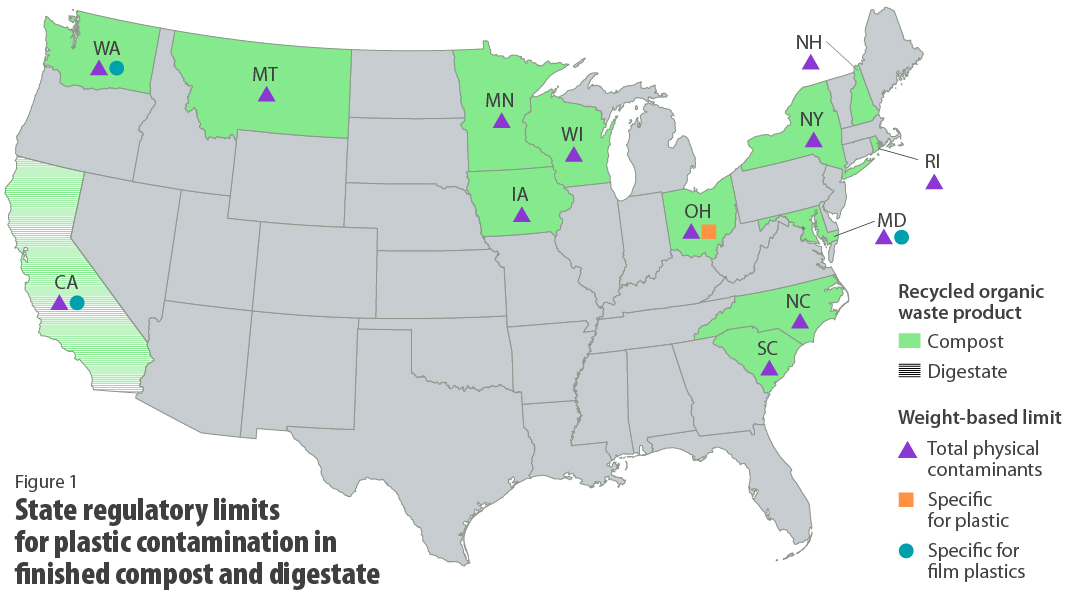 Plastic Contamination Research Gaps
Plastic Contamination Research Gaps
The issue paper states, “Plastic contamination in food waste streams and its implications for food waste management, and for human health and the environment, is an emerging issue in the early stages of investigation.” The authors cite the need for “scientifically rigorous data” to address several research gaps they identified. Research is necessary to:
- Discover the level of plastic contamination and associated particle sizes (e.g., microplastics or nanoplastics) in finished composts and digestates generated from food waste and used as soil amendments in the U.S — and ascertain the contribution of food waste to plastic contamination in these products.
- Determine the impacts of technologies (e.g., shredders, grinders and depackagers) commonly used by processors on the level of plastic contamination and size of plastic particles.
- Determine the effect of microplastic contamination on greenhouse gas and ammonia emissions levels during composting and methane yield from anaerobic digestion.
- Identify the most effective strategies to prevent plastic contamination in food waste streams.
- Assess exposure and the potential risks to human health and the environment from land application of plastic-contaminated compost and digestates.
Persistent Chemical Contaminants
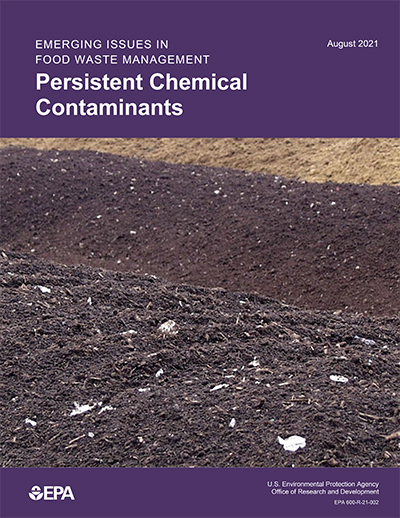 The second issue paper, Emerging Issues In Food Waste Management: Persistent Chemical Contaminants, focuses primarily on PFAS, but also covers pesticides and other persistent chemical contaminants, e.g., clopyralid and polycyclic aromatic hydrocarbons. The following sums up an overarching finding of this issue paper: “….. food waste streams are a source of per- and polyfluoroalkyl substances (PFAS) contamination in composts and digestates, with PFAS detected in food waste, food contact materials, and composts produced from food waste. …. The presence of PFAS in food waste is further supported by multiple studies reporting PFAS in food (i.e., precursor of food waste) from noncontaminated areas.” The authors also point out in the Executive Summary that “data on PFAS in food waste is limited,” and do include concentrations detected in these streams that they found in the literature.
The second issue paper, Emerging Issues In Food Waste Management: Persistent Chemical Contaminants, focuses primarily on PFAS, but also covers pesticides and other persistent chemical contaminants, e.g., clopyralid and polycyclic aromatic hydrocarbons. The following sums up an overarching finding of this issue paper: “….. food waste streams are a source of per- and polyfluoroalkyl substances (PFAS) contamination in composts and digestates, with PFAS detected in food waste, food contact materials, and composts produced from food waste. …. The presence of PFAS in food waste is further supported by multiple studies reporting PFAS in food (i.e., precursor of food waste) from noncontaminated areas.” The authors also point out in the Executive Summary that “data on PFAS in food waste is limited,” and do include concentrations detected in these streams that they found in the literature.
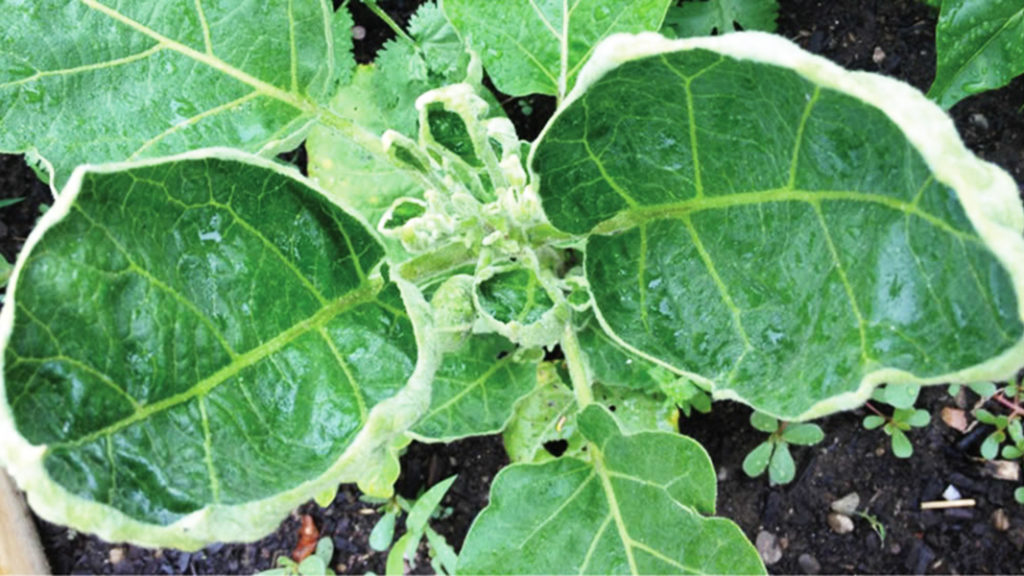
The Persistent Chemical Contaminants issue paper covers the phytotoxic effects of persistent herbicides that can include curling and twisting of plant leaves. Photo courtesy of University of Vermont
PFAS was detected in composts made from a variety of mixed feedstocks, such as food waste, green waste (leaves and grass), and manure. Other findings in this Emerging Issues paper include:
- Comparing results across three studies, which originated from the same research group, PFAS concentrations decreased in the following order (from highest levels detected to lowest levels detected): biosolids-based products (i.e., treated biosolids, composted biosolids); food waste compost; green waste compost.
- The limited data showed that PFAS concentrations were higher in composts with compostable food packaging and that compostable food contact materials have higher PFAS concentrations than non-compostable samples.
- No data on digestates were identified that would enable the determination of whether food waste digestates would have higher, similar, or lower PFAS concentrations compared with digestates produced from other feedstocks.
- There are currently no standards for PFAS in composts or digestates; however, guidelines and standards have been adopted recently by some cities and states to prohibit PFAS in food packaging and some manufacturers have begun voluntary phase-out. For example, says the issue paper, “compostable food contact materials certified by the Biodegradable Products Institute may no longer contain intentionally added fluorinated chemicals. These guidelines and standards should lead to decreased PFAS levels in food waste streams.”
- Much remains unknown about the risks to human health and the environment posed by the land application of food waste compost and anaerobic digestate containing PFAS, state the authors.
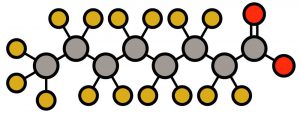
Perfluorooctanoic acid (PFOA)
Image: molekuul_be/Shutterstock.com
Priority research needs they identified include:
- Obtain additional field data on PFAS species and concentrations in finished composts and digestates generated from food waste and used as soil amendments in the U.S.
- Obtain additional data on PFAS species and concentrations in food waste streams in the United States.
- Assess exposure and potential risks to human health and the environment from land application of PFAS-contaminated compost and digestate produced from food waste.
- Understand the comparative risks of different management options, including further research to determine the fate of PFAS through various wastewater and solids treatment processes.
The authors also found that additional research needs to include “development of a multi-laboratory validated analytical method to detect PFAS in solids; expansion of PFAS analytical methods to identify more compounds; research on PFAS fate and transformation during composting and anaerobic digestion; research to support determination of an acceptable PFAS limit for land-applied soil amendments; and research on the long-term impacts and transformation of PFAS after land application of PFAS-contaminated soil amendments.”
Both papers can be downloaded from the EPA’s food waste research webpage.


